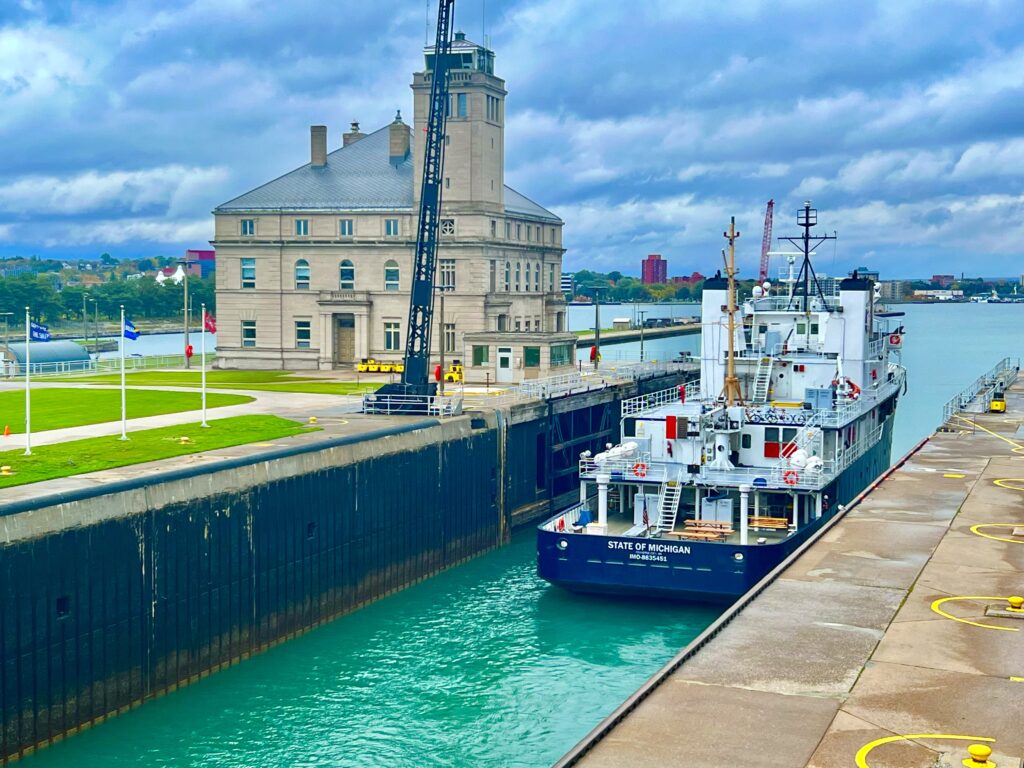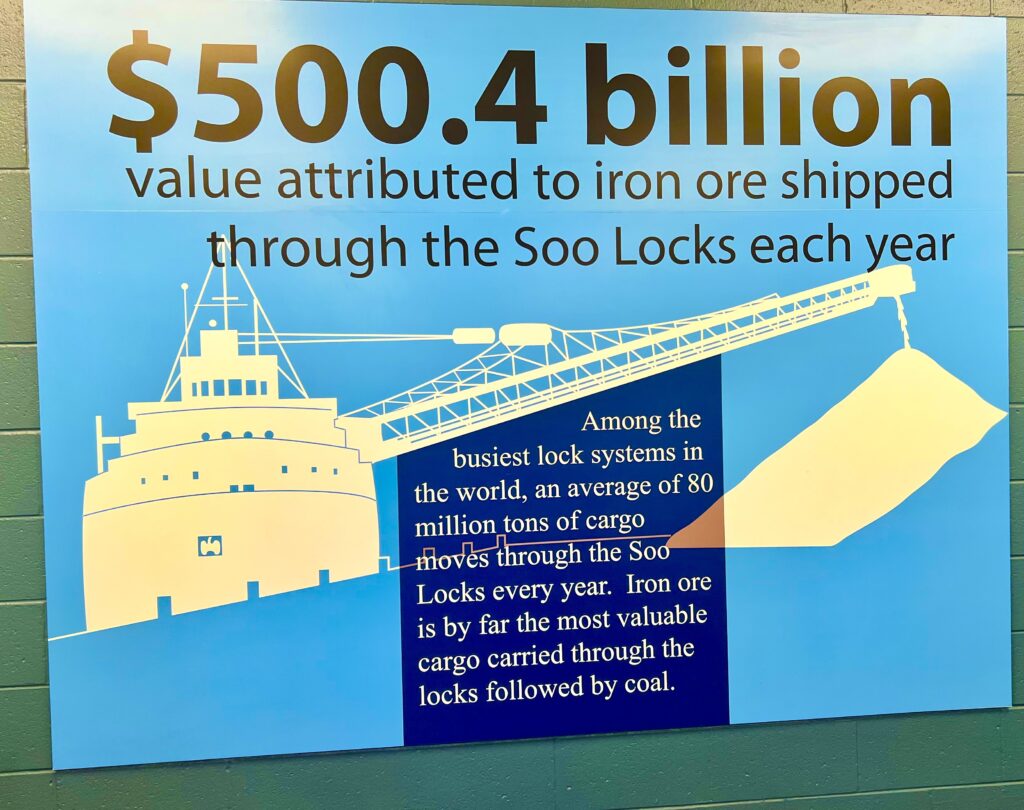The Soo Locks might just be the most important piece of American infrastructure you’ve never heard of. Located in the town of Sault Ste Marie, on Michigan’s Upper Peninsula, the Soo Locks are the busiest locks in the world, with more than 7,000 ships passing through each year. The locks allow freighters to travel from Lake Huron to Lake Superior, giving them access to Duluth, Minnesota, the most important port on the Great Lakes. The locks are necessary, because the water level in Lake Superior is 21 feet higher than Lake Huron.
Alright, so what? That may not seem all that consequential, but I promise you care about the Soo Locks. While a variety of cargo passes through the Soo Locks each year, most of the tonnage is iron ore, that all important raw ingredient for steel. Each year, $500 billion dollars worth of iron ore passes through the Soo Locks. A necessary stop on its journey to steel mills all across the Great Lakes region. Most of that iron ore originates in the great iron ranges of Minnesota, where it’s transported by rail to Duluth, and then loaded onto massive bulk cargo ships, which transport it across the Great Lakes.

The Soo Locks are such a crucial piece of infrastructure, that the Department of Homeland Security studied the economic impact of an unexpected closure of the locks. The report, which was obtained by the Detroit Free Press through the Freedom of Information Act, concluded that a 6 month closure of the Soo Locks, would result in the loss of 11 million jobs and cause a nationwide recession. Not only would the American steel industry be crippled, but the effects would ripple throughout a wide variety of manufacturing industries.

This supply chain remains critical to the American economy, but it was even more important in previous decades. During WWII, the Soo Locks were so important, that they were one of the most heavily guarded sites in America. At the peak, 12,000 troops were garrisoned near the Soo Locks. In addition to the troop presence, the locks were protected by barrage balloons, torpedo nets, and anti-aircraft guns. Defense of the locks was critical, as any disruption would have been disastrous, starving factories of the steel needed to produce battleships, tanks, artillery, landing craft, destroyers, machine guns, and airplanes.
Throughout the war, as much as 90% of America’s iron ore traveled through the Soo Locks. The extreme concentration is due to the fact that iron ore mining itself was concentrated. 70% of our iron ore came from mines in Minnesota’s Iron Range. In fact, 25% of America’s iron ore was coming from a single mine, the Hull-Rust-Mahoning Mine, located in Minnesota’s Mesabi Range. All of that ore had to pass through the Soo Locks before it could reach steel mills in Michigan, Indiana, Ohio, and Pennsylvania.

While the Soo Locks are interesting because of their economic and historical significance, it’s also really cool to watch 1,000 foot freighters traversing the locks. There’s a really nice observation platform alongside the locks, so you can get really close and enjoy a great view of the locks in action. I was actually really surprised how many people were visiting the locks, doing the same thing I was. I looked it up, and turns out 500,000 people visit the Soo Locks every year. That’s a very respectable number, and on par with quite a few National Parks.


In addition to the observation platform, the Army Corps of Engineers operates a visitor center, which is really well done. The visitor center has all kinds of interesting exhibits, and it’s not limited to just the Soo Locks. There is also some really cool displays explaining how Great Lakes shipping works. I appreciated the more general information because the Great Lakes are one of our great economic resources, yet people living outside the region often don’t understand how important they are. For that reason alone, the Soo Locks are worth a visit. Not to mention they’re really cool.


For those of you who think I’m crazy, I realize most people aren’t going to travel up to Sault Ste Marie just to visit the Soo Locks. The good news is you don’t have to. I haven’t written about it yet, but Michigan’s Upper Peninsula is awesome. I imagine most of the 500,000 people who visit the Soo Locks each year, do so as part of a larger trip to the UP. The Upper Peninsula is incredibly beautiful, and there’s all kinds of cool stuff to do. So if the Soo Locks seem cool to you, keep an eye out for upcoming posts on the Upper Peninsula. You may find a couple of excuses to take a trip up to Michigan.
https://saultstemarie.com/attractions/soo-locks/


This is the kind of info we need to be teaching to school she kids. How were they affected during Covid? Did things shut down for a bit?
Samantha recommended I start an Infrastructure 101 series, this was my trial balloon. I’ve done a bunch of this stuff, but not sure how interesting other people find it. I would have showed up to school more if we were learned about this kind of stuff. ☺️
No shutdown, it’s too essential. Barring an actual problem with the locks they are open 24/7 during the shipping season. The locks are only closed during the winter, when they shutdown for maintenance.